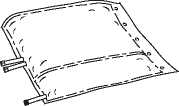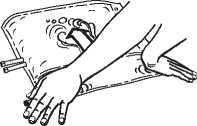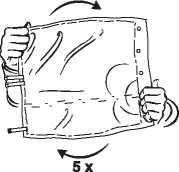Duosol Without Potassium Solution For Haemofiltration
688911D_Duosol-K0-GB 16.04.15 09:49 Seite 1 (^)
Package leaflet: Information for the patient
Duosol without Potassium solution for haemofiltration
Read all of this leaflet carefully before you are given this medicine because it contains important information for you.
- Keep this leaflet. You may need to read it again.
- If you have any further questions, ask your doctor or pharmacist.
- If you get any side effects, talk to your doctor or pharmacist. This includes any possible side effects not listed in this leaflet. See section 4.
What is in this leaflet
1. What Duosol without Potassium is and what it is used for
2. What you need to know before you are given Duosol without Potassium
3. How to use Duosol without Potassium
4. Possible side effects
5. How to store Duosol without Potassium
6. Contents of the pack and other information
1. What Duosol without Potassium is and what it is used for
Duosol without Potassium is a solution for haemofiltration. It is intended for use in patients with acute kidney failure, when the kidneys are no longer able to remove waste products from the blood. Continuous haemofiltration is a procedure which is used to remove the waste products from the body which would otherwise be excreted via the kidneys in urine. The solution corrects the fluid balance and ensures that salt (electrolyte) losses are replaced following treatment.
2. What you need to know before you are given Duosol without Potassium Duosol without Potassium should not be given if
- you have an abnormally low blood potassium level (hypokalaemia)
- your blood contains abnormally low acid levels (metabolic alkalosis).
The haemofiltration procedure itself should not be used if
- you have kidney failure in combination with a very high metabolic turnover (hypercatabolic state), in which situation the accumulation of waste products in your body can no longer be corrected by haemofiltration
- you have poor blood flow from the site of insertion of the cannula in the vein
- you have a high risk of bleeding because you receive drugs to prevent blood clotting (systemic anticoagulation).
Warnings and precautions
Talk to your doctor or pharmacist before you are given Duosol without Potassium.
Before and during haemofiltration your blood pressure, fluid balance, salt (electrolyte) balance, acid-base
balance and kidney function will be monitored. Your blood sugar and phosphate levels will regularly be checked.
Furthermore serum potassium concentration will be monitored before and during haemofiltration.
Other medicines and Duosol without Potassium
Tell your doctor or pharmacist if you are taking, have recently taken or might take any other medicines. The level of other medicines in your blood may be reduced during haemofiltration and your doctor will take this into account.
Interactions with other medicines can be avoided by ensuring that the correct dose of the solution for haemofiltration is used and by careful monitoring. The following interactions will be considered:
- Infusions given in intensive care may change the composition of your blood and your fluid status.
- Toxic effects of certain medicines used to treat heart weakness (medicines containing digitalis) may not become apparent if your potassium or magnesium levels are too high or your calcium levels are too low. If those levels are corrected by haemofiltration, the toxic effects may then occur and cause for instance an abnormal heart rhythm. If you have low potassium levels or high calcium levels in your blood, digitalis may have toxic effects at doses lower than those usually used for therapy.
- Vitamin D and medicines containing calcium can increase the risk that the calcium level in the blood rises to abnormally high values (hypercalcaemia).
- Additional use of sodium hydrogen carbonate can increase the risk of abnormally low acid levels in the blood (metabolic alkalosis).
Pregnancy, breast-feeding and fertility
If you are pregnant or breast-feeding, think you may be pregnant or are planning to have a baby, ask your doctor or pharmacist for advice before you are given this medicine.
There are at present no data known regarding the use of solutions for haemofiltration during pregnancy. However, because all the ingredients of this medicine are naturally occurring substances only replacing the same substances lost from the body during haemofiltration, no risks for the child are to be expected during pregnancy and breast-feeding, and no effects on fertility are to be expected.

Driving and using machines
This medicine is normally given to immobile patients in a hospital/dialysis unit. This will exclude driving and using machines.
3. How to use Duosol without Potassium
You will only be given this medicine under the direction of a doctor with experience in haemofiltration techniques.
Your doctor will decide on the proper dose for you, taking into account your clinical status, your body weight and your metabolic condition. Unless otherwise prescribed, a filtration rate of 20-25 ml/kg body weight per hour is recommended for patients of all ages for the removal of those substances which are normally excreted in the urine.
You are given the ready-to-use solution for haemofiltration via the tubing of the haemofiltration apparatus (the so-called extracorporeal circulation) using an infusion pump.
The treatment of acute kidney failure is carried out for a limited time period and ends when kidney function is fully restored.
If you are given more Duosol without Potassium than recommended
There have been no reports of life-threatening situations following the administration of the prescribed dose of this medicine. The administration can be stopped immediately, if required.
Unbalanced administration can result in too much or too little fluid being present in the body (hyperhydration or dehydration). This situation can become apparent through changes in blood pressure or pulse.
Hydrogen carbonate overdose can occur if a too large volume of solution for haemofiltration is given. This can lead to abnormally low acid levels in the blood (metabolic alkalosis), less calcium dissolved in the blood (decrease of ionised calcium) or muscle cramps (tetany).
An overdose can be the cause of a heart failure and/or congested lung and can cause changes in the salt (electrolyte) balance and acid-base balance.
Your doctor will decide on the appropriate treatment. If you have any further questions on the use of this medicine, ask your doctor or pharmacist.
acid levels in the blood (metabolic alkalosis), high or low blood pressure (hypertension or hypotension), feeling sick (nausea), being sick (vomiting) and muscle cramps.
Reporting of side effects
If you get any side effects, talk to your doctor or pharmacist. This includes any possible side effects not listed in this leaflet. You can also report side effects directly via the Yellow Card Scheme at www.mhra.gov.uk/yellowcard. By reporting side effects you can help provide more information on the safety of this medicine.
5. How to store Duosol without Potassium
Keep this medicine out of the sight and reach of children.
You should not be given this medicine after the expiry date which is stated on the bag and on the carton after "EXP". The expiry date refers to the last day of that month.
Storage conditions
Do not store above 30 °C. Do not refrigerate or freeze.
Storage conditions after preparation of the ready-to-use solution
The mixed product should be used immediately. The mixed product is physically and chemically stable for 24 hours at 25 °C.
4. Possible side effects
Like all medicines, this medicine can cause side effects, although not everybody gets them.
At present, no side effects associated with this medicine have been reported, however, the following side effects are possible. The frequency of these side effects is not known (cannot be estimated from the available data):
Too much or too little fluid in the body (hyperhydration or dehydration), abnormal salt (electrolyte) levels, low blood phosphate levels (hypophosphataemia), high blood sugar levels (hyperglycaemia), abnormally low


|
Small Chamber |
Large Chamber | |||
|
Electrolyte Solution |
Bicarbonate Solution | |||
|
The active |
555 ml |
per |
4445 ml |
per |
|
substances are: |
contain |
1000 ml |
contain |
1000 ml |
|
Sodium chloride |
2.34 g |
4.21 g |
27.47 g |
6.18 g |
|
Calcium chloride dihydrate |
1.10 g |
1.98 g |
-- |
-- |
|
Magnesium chloride hexahydrate |
0.51 g |
0.91 g |
-- |
-- |
|
Glucose monohydrate |
5.49 g |
9.90 g | ||
|
equivalent to glucose anhydrous |
5.0 g |
9.0 g | ||
|
Sodium hydrogen ca rbonate |
-- |
-- |
15.96 g |
3.59 g |
6. Contents of the pack and other information What Duosol without Potassium contains
|
Electrolytes: |
[mmol/ chamber] |
[mmol/l] |
[mmol/ chamber] |
[mmol/l] |
|
Na+ |
40.0 |
72 |
660 |
149 |
|
Ca2+ |
7.5 |
13.5 |
-- |
-- |
|
Mg2+ |
2.5 |
4.5 |
-- |
-- |
|
Cl- |
75.0 |
135 |
470 |
106 |
|
HCO3- |
-- |
-- |
190 |
42.8 |
|
Theoretical osmolarity [mOsm/l] |
275 |
297 | ||
Composition of the ready-to-use solution for haemofiltration after mixing:
1000 ml ready-to-use solution for haemofiltration contain [mmol/l]:
Na+
Ca2+
Mg2+
Cl-
HCO-
Glucose anhydrous Theoretical osmolarity [mOsm/l] pH
This medicine is delivered in a two-chamber bag. Mixing of both solutions by opening the seam between the two chambers results in the ready-to-use solution for haemofiltration.
2 bags of 5000 ml (two-chamber bags, 4445 ml and 555 ml) per carton
Marketing Authorisation Holder and Manufacturer
B. Braun Avitum AG Schwarzenberger Weg 73-79 34212 Melsungen Germany
This medicinal product is authorised in the Member States of the EEA under the following names:
Duosol bez kalia
Duosol ilma kaaliumita,
hemofiltratsioonilahus
Duosol sine Kalium
hemofiltraationeste
Duosol senza potassio soluzione
per emofiltrazione
Duosol bez kalija
skldums hemofiltracijai
Duosol K 0 hemofiltracijos
tirpalas
Duosol ohne Kalium Hamofiltrationslosung Duosol nie zawierajgcy potasu Duosol brez kalija raztopina za hemofiltracijo Priosol sin Potasio solucion para hemofiltracion
Duosol zonder Kalium, oplossing voor hemofiltratie Duosol without Potassium solution for haemofiltration
This leaflet was last revised in March 2015.
140
1.5 0.5
109
35.0
5.6 (equiv. to 1.0 g) 292
7.0-8.0
Czech Republic: Estonia:
Finland:
Italy:
Latvia:
Lithuania:
Germany, Luxembourg:
Poland:
Slovenia:
Spain:
The Netherlands: United Kingdom:
The other ingredients are:
Electrolyte solution (small chamber)
Hydrochloric acid 25% (for pH adjustment),
water for injections
Bicarbonate solution (large chamber)
Carbon dioxide (for pH adjustment), water for injections
What Duosol without Potassium looks like and contents of the pack
Solution for haemofiltration
Clear and colourless solution, free from visible particles
The following information is intended for healthcare professionals only:
INSTRUCTIONS FOR PREPARATION OF THE READY-TO-USE SOLUTION FOR HAEMOFILTRATION
The container and the solution must be visually inspected prior to use. The solution for haemofiltration must only be used if the container (outer wrap and two-chamber bag), peel seam and connectors are undamaged and intact and if the solution is clear and colourless and free from visible particles.
Remove outer wrap only immediately before use.
Remove the outer wrap.
2.| Unfold the bag and place it on a clean, flat surface.
3.| Press with both hands on the smaller chamber of the bag until the peel seam opens fully along its entire length.
4.| Ensure the contents are thoroughly mixed by twisting the bag 5 times back and forth.



5 x

ADMINISTRATION OF THE READY-TO-USE SOLUTION FOR HAEMOFILTRATION
The solution for haemofiltration should be warmed to approximately body temperature by an integrated or external heater. The solution must not be infused under any circumstances if below room temperature.
Q/U6889
During application of this medicinal product, white calcium carbonate precipitation has been observed in the tubing lines in rare cases, particularly close to the pump unit and the heating unit. Therefore, the solution in the tubing lines should be closely visually inspected every 30 min during haemofiltration in order to ensure that the solution in the tubing system is clear and free from precipitate. Precipitations may occur also with substantial delay after start of treatment. If precipitate is observed, the solution and the tubing lines must be replaced immediately and the patient carefully monitored.
For single use only. Any unused portion of solution and any damaged containers must be discarded.
